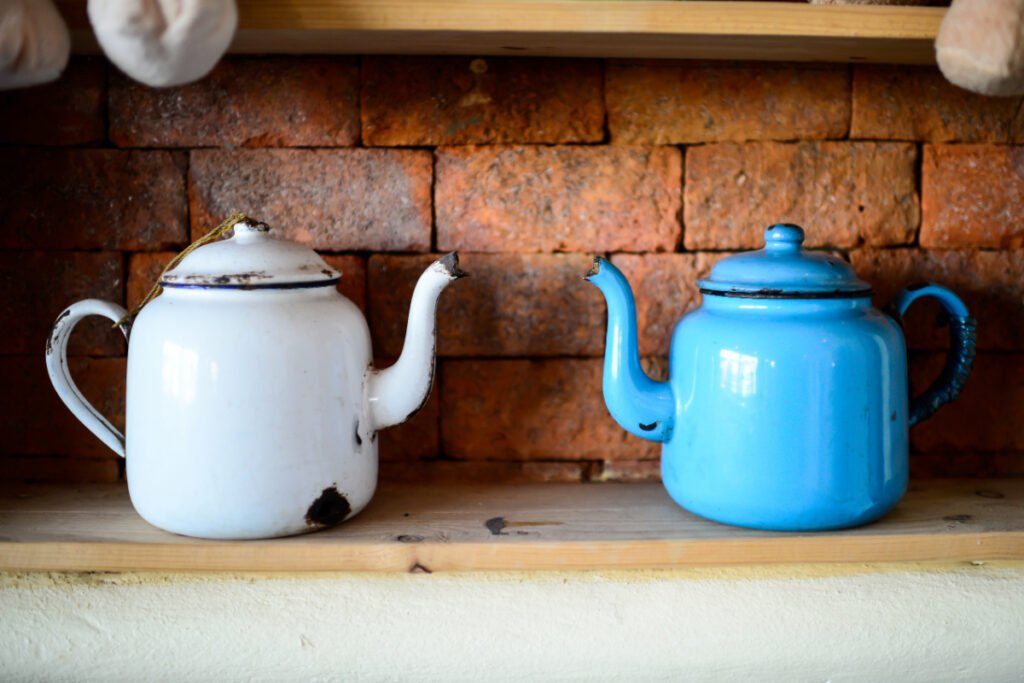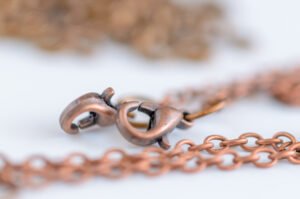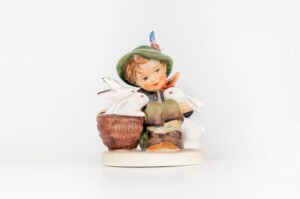As an avid collector, I’ve always been fascinated by antique kitchen items. And out of all the old, artistic items, vintage teapots are something that always left me mesmerized for their ornate designs, motifs, and unique shapes.
Tingled by my senses to learn more about these vintage containers, I did quite a lot of research on old teapots from different areas, their features, and much more. So, join me as I share my learnings on spotting a vintage teapot and assigning the right value to it!
KEY TAKEAWAYS
- Teapot styles like Georgian (the first European models), Louis (the Victorian era), and Queen Anne (the 18th century) typically belong to the vintage list.
- The more unique a teapot’s shape, the more likely it is to be an antique, like pear-shaped teapots from the 17th century.
- Yixing Zisha Teapot, sold for $2 million, displays the first kind of teapot made around the 1500s in China. Even its clay is rare and not easily found.
- Spout irregularity on antique teapots is a good sign since early pots were crafted by hand, not machines.
What Makes Antique Teapots Unique?

Antique teapots are heavier than their modern counterparts because they were made from heavy materials. Below are more features that explain how antique teapots are different from contemporary ones.
- 3-4 uneven spoutholes on teapots usually date back to the 18th century
- Not perfectly round since it was meticulous handwork with attention to detail
- Made from heavy materials like silver, ceramic, and pewter
- Company’s logo or markings on teapots’ undersides or base
- Embedded finger smudges ensure old and probably an antique model
- No glazing under the lid and inside the rim of a teapot made before the 18th century
Brief History of Antique Teapots
The first teapot, known as Yixing, was built in China and made from the purple clay known as ‘Zisha’ brought from Jiangsu province. When fired, the teapot produced shades of brown, absorbing the tea’s natural oils and enhancing the flavor.
The word then reached Japan, where earthen pots were known as Kyusu. And by the 17th century, Chinese Emperor Kang Xi decided to export the Yixing teapots to Europe.
China had already started producing porcelain teapots embellished with metals, motifs, and designs during the Ming Dynasty. With the onset of the 18th century, Queen Victoria introduced the silver teapot set, from which several styles of vintage teapots emerged and evolved.
With time, teapots also reached Russia as Chinese herbs, Central Asia, and other regions by Persian, Indian, and European traders, and so on. But the new models were more polished and machine-made, which made them common!
Types of Vintage Teapots Based on Designs
Many different varieties of antique teapots emerged from different regions, giving us these six main types of antique teapots:
1. Figural Teapots
These teapots display hand-painted men, women, historical figures, children, and political personalities and are priced between $40 – $1,900. This teapot type gained popularity around the 17th century in Europe and still has that old-world charm.
2. Floral Pots
These stunning pots display flowers like roses, cherry blossoms, daisies, trees, and leaves. Such types of teapots cost around $20 to $6,000. You can find the most delicate floral patterns on vintage teapots made from bone china during the Louis (Victorian) era.
3. Animal Teapots
As the name suggests, such teapots display or are molded into cats, dogs, birds, fish, and dragons, costing between $50 – $1,800. From pre-1800s dragon designs in China to equestrian themes in England during the Victorian era, these teapots have always been collectors’ favorites.
4. Vehicle Teapots
Antique teapots also exhibit types via hand-painted or hand-carved vehicles, like cars, trains, boats, carriages, etc. Their estimated cost is close to $40- $1,000 as single units since they have been around since the 16th- 17th century and, thus, are pure vintage.
5. Regional Motifs
From Japanese artworks and English countryside to French sceneries and Chinese landscapes, regional motifs were usually painted on porcelain or bone china since the 18th century and are currently priced between $50 and $6,000.
6. Commemorative Teapots
These teapots showcase cultural revolution, innovations, and individual achievements and cost between $70 – $700 or more. Commemorative antique teapots have been making waves since the 18th and 19th centuries in Japan, China, and Europe!
7 Factors to Identify & Value Antique Teapots
Various factors, such as style, age, theme, materials, condition, etc., can help you spot and value a vintage teapot. So, let’s have a look at these factors below!
1. Popular Teapot Styles

The first teapot, Yixing, was made from a special clay around the 1500s, from where it took a flight to Japan, Central Asia, and the West. Their teapots thrived, and styles like Louis, Georgian, and Art Deco emerged.
Have a look at this table to understand the details and price range of antique teapots via their styles.
| Antique Teapot Style | Unique Features | Estimated Costs (Single Units) | Estimated Costs (Set) |
| Yixing (10th -15th century) | Use of special clay called ‘Zisha, Simple designs, Brown-red color, arched lid, made in China | $15 – $5,000 | $15 – $1,000 |
| Georgian (Late 17th century) | Short & round, Small stout, a large mouth causing spillage, Early European teapot model | $20-$7,500 | $50 – $2,500 |
| Louis (Victorian Era) | Baroque-Rococo inspired designs, Floral motifs, flowery texture, Rise of the silver set, markings displaying hallmark procedure duty markings & purity test, Baluster form | $30 – $1,600 | $15 – $500 |
| Queen Anne (18th Century) | Vertical designs, Curvy and Angular spout, Typically made from bone china, including the RARE gold hand-painted collection | $25 – $2,500 | $15 – $3,000 |
| Indian (Late 18th Century) | Resembles Louis teapots but more detailed, made from silver, brass, & porcelain, markings include hall procedure and purity tests, traditionally taller | $20 – $7,500 | $30 – $ 3600 |
| Bachelor (18th-19th Century) | Considerably smaller than others (like Aladdin’s lamp), Inspired by Queen Anne style, Similar to Art Deco work in various designs | $50 – $6,200 | $20 – $1,000 |
| Art Nouveau (Mid 18th- 19th century) | Bold colors, Geometric patterns, Circular base for lifting Popularized the mixed straight lines emerging as quirky angles collection, Avant-garde designs | $80 -$1,500 | $70 – $1,300 |
| Art Deco (19th – 20th century) | Bold colors, Geometric patterns, and Circular bases for lifting Popularized the mixed straight lines emerging as quirky angles collection, Avant-garde designs | $15 – $12,000 | $50 – $ 1,300 |
2. Shapes & Designs

The earliest teapots were round with a few holes in the spout, which ensured their antiqueness. The western antique teapots were rounder, while the eastern ones were more squat and circular.
So, how will you use the era of a vintage teapot to evaluate its price? Find out below.
| Antique Teapot’s Shape and Design | Time Period | Estimated Costs(Single Units) |
| Round | Until 17th century | $15 – $1,000 |
| Oval or Pear-shaped | 17th century | $30 – $1,800 |
| Straighter Sides | 18th century | $15- $1,500 |
| Squat or Circular | 18th century (East) | $15 – $1,200 |
| Rounder than before | 18th – 19th century (West) | $50 – $200 |
3. Materials

One of the easiest ways to test an antique container is to look at its material. For instance, clay was used in China between the 10th to 15th centuries before bronze, ceramic, porcelain, silver, and steel followed.
The table below will help you distinguish teapots of different eras with the material & their prices.
| Antique Teapot Materials | Time Period | Estimated Costs (Singe Units) | Estimated Costs (Rare models) |
| Clay | 10th – 15th century | $25 – $700 | $5,000 |
| Bronze | Pre-17th century | $40 – $3,000 | $90,000 |
| Brass | Pre-18th century | $40 -$900 | $15,000 |
| Copper | Victorian Era | $40 – $900 | $10,000 |
| Porcelain | 16th century | $20 – $1,500 | $25,000 |
| Ceramic | 15th-16th century | $30 – $2,200 | $20,0000 |
| Silver | 17th century | $25 – $6,000 | $20,000 |
| Pewter | 17th century | $20 – $500 | $3,000 |
| Bone China | 18th century | $15 – $200 | $1,300 |
| Gold | 18th century | $20 – $7,000 | $15,000 |
| Steel | 19th century | $25 – $180 | $400 |
4. Manufacturing Dates & Age

Every antique teapot is defined by a different era based on its material and design. For instance, steel teapots were the result of mass production owing to the rising popularity of teapots in the West, so they belong to the 19th century.
You can learn more about the timeline of antique teapots with features that separate them in the table below.
| Antique Teapots Historical Timeline | Specific Features | Estimated Costs (Single Units) |
| 1500s | Made of clay, Yixing teapots, no pattern, red-brown color, handmade, round shape | $40 – $7,000 |
| Pre 17th century | Ceramic and porcelain pots, round, bronze teapots | $20 – $5,000 |
| 17th century | Brass and silver material, Georgian and Queen Anne designs, pear-shaped pots | $ 30- $2,500 |
| 18th century | Louis and Bachelor designs, straighter sides, bigger sizes, lesser weight, Pewter, bone china, and gold material included | $50 -$6,000 |
| Victorian Era | Silver, bone china, and pewter pots, Indian and Victorian designs, squat and circular shapes popularized in east | $30-$4,000 |
| 19th century | Steel, porcelain, silver, ceramic teapots, rounder shape, varied designs following artistic lines | $40 – $28,000 |
| 20th century | Avant-garde designs, Art Deco style, geometric patterns, circular base | $20 – $16,000 |
5. Antique Teapot Brands & Markings

Meissen’s teapots have made waves since the early 1700s, and you can find original pieces in thrift or online stores even today. You can check specific markings like the firm’s logo, lettering, and serial no on the sides or at the bottom of the pot.
Here’s a list of popular vintage teapot brands and their estimated resale prices.
| Antique Teapot Brands | Specific Markings | Estimated Costs (Single Units) |
| Manning Bowman & Co. (18th century) | Firm’s name, patent info lettered on the sides or bottom, Bird symbol with M and B inscribed on its sides | $20 – $200 |
| Gibson and Sons (19th century) | Crown-shaped logo at the base, Brand’s name, serial no, England, inscribed right below the symbol | $15 – $130 |
| Fukagawa (18th-19th century) | Firm’s name embossed on the bottom in Japanese, ‘MADE IN JAPAN’ written below the brand’s name, Delicate designs on porcelain material | $20 – $200 |
| Meissen (17th-19th century) | Unique logo on the bottom, Floral, hand-painted designs, Distinctive collection, including its signature helmeted bearded man holding a dolphin | $40 – $1,520 |
6. Condition
The lesser the damage, the higher the value of the teapot – stick to this rule!
Even so, a teapot that has been in use for more than 50 years will have some wear and tear or exhibit signs of discoloration. But you must have an eye to look for extreme damage, or it will lose its vintage touch.
7. Weight and Size
Vintage teapots are usually smaller as the tea was quite expensive back then, so people consumed it in small quantities. Also, antique pots weigh heavier than modern ones since they are made from heavier metals, like brass, silver, and gold.
Which is the Most Expensive Antique Teapot in the World?
The Egoist Teapot, designed by Nirmal Sethia and encrusted with diamonds, was sold for a whopping $3 million.
Is it Safe to Drink Out of an Antique Teapot?
It is recommended to consult an expert before drinking from a vintage teapot as it may have a cracked enamel which may contain lead or radioactive oxide.
Where Should I Sell My Antique Teapot?
You can buy or sell antique teapots on Etsy, eBay, Amazon, and British Novelty Teapots, amongst other online stores.
I hope this article will now be your go-to place for the identification and valuation of antique teapots. Use it to give or get a fair value for your beautiful tea container, considering that it may have once been used by a king or a queen!
If you want more detailed guides on antique kitchenware items, like antique flatware patterns, old Corningware patterns, or antique spoons, join me right away!
Note: This article is intended for informational, educational, and entertainment purposes only. Some images are illustrative and may not represent actual brands, products, or related entities. All trademarks, product names, brand logos, packaging, and other intellectual property referenced remain the exclusive property of their respective owners. Any brand mentions or references are provided solely for descriptive and educational context and do not imply any formal or commercial association.









